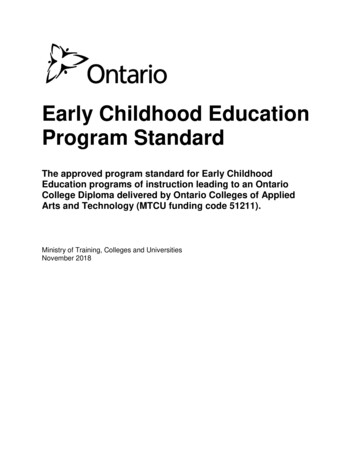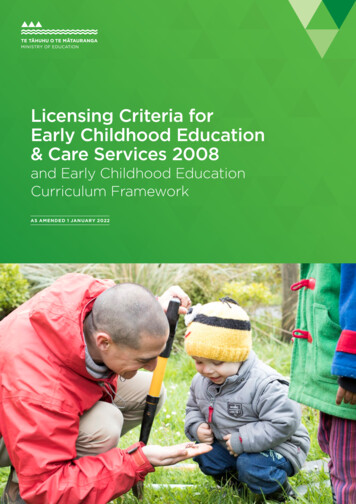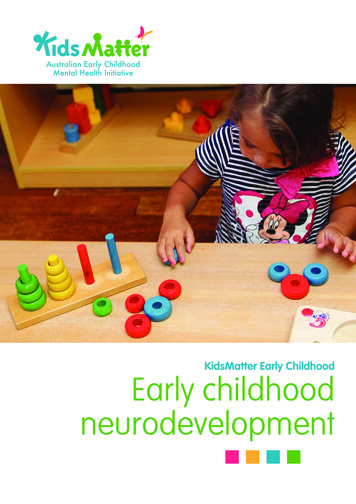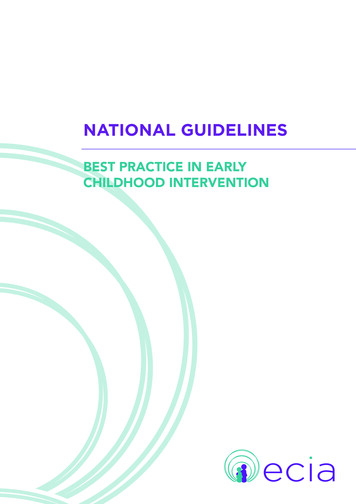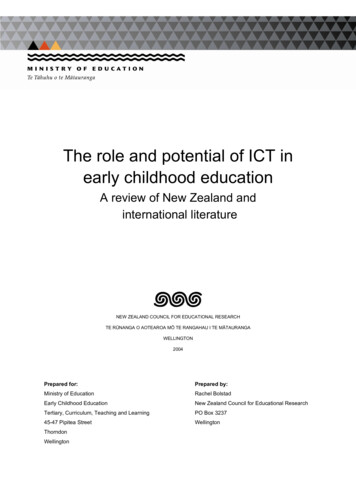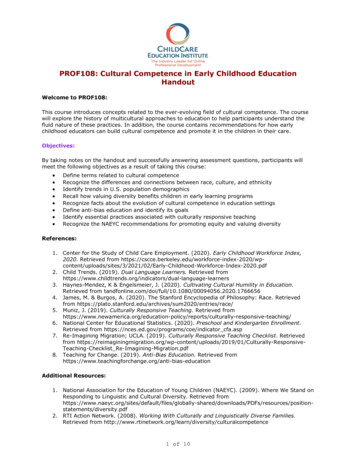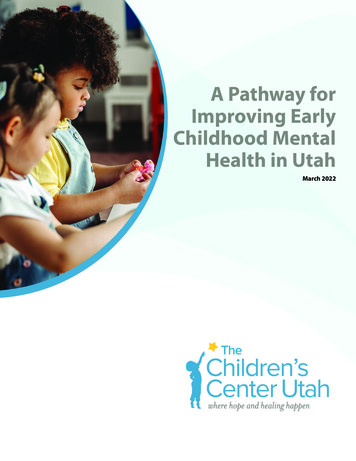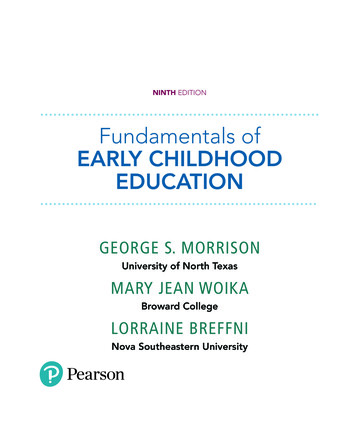
Transcription
P a g e 1Creating High Quality Early Childhood Learning CentersIntroductionPeter C. Lippman, Assoc. AIA, REFPEducaitonal facility Planner Researcher Educator School DesignerAt the forefront pinnacle of national agendas around the world is Early Childhood Education (ECE). Why create high quality early childhood learning environments?The reason for this is a considerable, and rarely disputed, body of evidence that consistentlydemonstrates that children who attend high quality early care settings benefit significantly. The mostcommonly cited findings are that children who are educated at very young ages are able to perform ata higher academic level, engage more appropriately with peers and authority, have a lower risk ofincarceration, and have a greater chance of finishing high school and attending the university, thanyoung children who do not receive early education (Gorley, 2011). Beyond the individual benefits,many experts have proposed that society profits from early childhood education through the reductionof poverty, greater employability and social mobility. Nonetheless, these benefits only occur whenchildren have attended “high quality” early learning centers (Heckman, 2011). What are the features of a high quality early childhood learning environment?How are these features integrated within a high quality early childhood learning environment?A high quality early learning environment is founded on the Building Blocks for Learning Brizard, 2016).These building blocks are the rubric for encouraging the healthy development of the child. Healthydevelopment affords the child the opportunity to acquire knowledge and master skills to make themready for school as well as provide them with a positive mindset for success in life. With these skills,learners can persevere independently transforming the worlds in which they live, learn, and play. Tocreate a high quality early childhood learning environment, the foundations for the building blocks reston: Leadership and teacher preparation, professional development and evaluationSupport and guidance for effective school culture and climateDesign and implementation of curriculum, assessments and pedagogical supports (e.g., stressreduction and self- regulation through mindfulness and contemplative practice)Systems of support and intervention for students (Brizzard, 2016).Since the goal of these settings is to provide opportunities for the development of the whole child,notions about the learning environment must extend beyond the social and curricular aspects of earlyeducation. For this reason, the physical environment must be investigated (Mathews & Lippman,2015). The premise of this paper is when programmed, planned, and designed in relationship to thebuilding blocks for learning, the spatial design becomes, yet, another building block. As the socialenvironment is prepared for developing effective practices for teaching and learning, the builtenvironment must be equipped and prepared to mediate and actuate these practices.The consequences are a fully integrated learning environment. In the following sections, Brizzard’sbuilding blocks for learning will be examined as they pertain to early childhood education. From this,healthy development, school readiness, and growth mindset will be described as a means forprogramming strategies Early Childhood Learning Centers (ECLC). Lastly, this paper will examineActivity Settings and Break-Out Spaces, to illustrate how the spatial design can beconceptualized for ECLCs to reinforce the building blocks for learning.The Building Blocks for LearningThe building blocks for learning as described by Brizzard (2016) are composed of five levels. For thelearner to be successful in school and life, they must climb the building blocks acquiring the skills fromPeter C. Lippman, Assoc. AIA, REFPEducational Facility Planner Researcher Educator School Designer
P a g e 2each level (Fig. 1). The learner starts at level 1, the foundation, which is healthy development. Movingvertically, as they master the skills they can ascend to the next level. They journey begins with healthydevelopment to level 2, school readiness; from level 2 to level 3, mindset for self and school; level 3to level 4, perseverance, and, finally, to level 5 is independence and sustainability. Even though skillsof the different levels may occur simultaneously, prior to climbing to the next level, given that the focusof this paper is on early-childhood learning environments, the first two rows and growth mindset fromlevel 3 will be examined.Fig. 1. Building Block for LearningHealthy development and school readiness are essential for creating effective early learning centers.Healthy development includes attachment, stress management, and self-regulation. These arelearned skills that develop when the child is situated in a supportive environment. A supportiveenvironment entails the child having positive relationships with adults. From these experiences, thechild learns to cope with and manage difficult situations. Additionally, the child learns to manage theiremotions so that they can engage in tasks to accomplish goals (Brizzard, 2016).Located just above the foundational skills is school readiness. School readiness includes selfawareness, social awareness/relationship skills and executive functions. In other words, these arethe needed social-emotional and cognitive skills that contribute to the child’s readiness to effectivelyand fully participate in school (Brizzard, 2016). With the acquisition of these skills, the child cansuccessfully negotiate themselves within the various settings of the learning environment and coconstruct knowledge with others, as they develop identities of themselves.Although Mindset of Self and school complete Level 3 of the building blocks for learning as crafted byBrizzard (2016), these capacities may be acquired concurrently as the learner appropriates skillsassociated with healthy development and school readiness. The features of this row are growthmindset, self-efficacy, sense of belonging, and relevance of school (Brizzard, 2016). By developinga growth mindset, the child not only understands, but realizes that achievement is a direct result ofeffort and hard work (Dweck, 2015), learners can acquire a sense of conviction that they are capableof success. With the shift to a growth mindset, learners understand the relevance of school and realizethat education is a pathway for achievement.In addition, learners develop place attachment / sense of belonging. Place attachment is the emotionalbond between learner and their learning environment (Low & Altman, 1992). Place attachment situateslearning in context and acknowledges the reciprocal relationship that occurs between behavior andexperiences (Lippman, 2010). Embedded in a specific time and place, the transformations of thelearners’ result from their transactions with their learning environments (Lippman, 2013). Hence,learners are shaped by their experiences, and, their experiences, in turn, impact them.Peter C. Lippman, Assoc. AIA, REFPEducational Facility Planner Researcher Educator School Designer
P a g e 3From Building Blocks of Learning to Programming EarlyChildhood Learning CentersDescribing a Supportive Environment for Healthy DevelopmentSupportive environments for infants, toddlers, and young children lead to their healthy development.Healthy development results from the personal attachments that children make within their immediatesocial environment. These attachments shape and influence their behaviors and motivations. Sincebehaviors are a result of the child’s reaction to external and internal stimuli, a supportive environmentbegins with attentive caregivers. Furthermore, caregivers model the desired behavior as well as areresponsible for understanding the children with whom they teach (Arndt, 2012). With the knowledgethat they acquire about the children, they can identify the reasons why the child transacts in particularways, and work with her/her to realize why s/he transacts with others in specific ways and situations.Furthermore, the caregiver(s) is the person(s) with whom the child can turn to in times of need. Whenassistance is needed and given, children are being transformed from their transactions. Thesetransactions shape their development and sense of attachment with their caregivers (Arndt, 2012).Positive transactions with attentive caregivers can lead to the child feeling safe and secure. Hence,creating stable and dependable attachments affords the child capacity to develop positive relationshipswith others.Fig. 2. Bold Park Community School, Perth, Australia (Photographer; Peter C. Lippman)Given this, learners who have developed stable attachments are best able to explore independently,identify potential stressful situations, and, by building on past experiences, determine how to resolvethem. Therefore, a supportive environment affords the child opportunities, the confidence to take risksand learn resiliency. For healthy development, the physical features of supportive learningenvironments may include clear site lines through the spaces, areas of prospect and refuge, areasthat the child can shape to feel safe and secure (Fig. 2), classrooms, and spaces, within as well asoutside classrooms where the child can meet with caregivers to work through stressful situations(Lippman, 2010).Preparing the Environment for School Readiness: Self-awareness, Social awarenessand executive functionsHealthy development is dependent on a supportive social environment. Building on this notion, aPeter C. Lippman, Assoc. AIA, REFPEducational Facility Planner Researcher Educator School Designer
P a g e 4supportive environment is also essential for school readiness. School readiness entails that the childdevelops an identity / self-awareness. It also entails learning how to share and negotiate with othersso that they may acquire higher order executive functions such as concept development, hypothesestesting, and problem solving (Williams, Huang, & Bargh, 2009). Furthermore, appropriating an identifyis on-going; for, Identity is the result of the individuals’ experiences in their social and physicalenvironments. These experiences of working with others, sharing thoughts, and mastering skillstransforms the child (Lippman, 2010; Lippman, 2006; Wenger, 1998).While each child is developing an identity of himself or herself, they are also recognizing, the emergingidentities of their peers. The recognition of others having identities is social awareness. Socialawareness results from knowledge acquisition which is co-constructed. Hence, knowledge is a humanproduct, which is socially and culturally constructed (Ernest, 1999; Gredler, 1997; Prawat & Floden,1994). Knowledge acquisition, learning, is socially constructed, does not take place only within anindividual, nor is it passive (McMahon, 1997), but rather occurs when individuals are engaged in socialactivities.Fig. 3. Eni Nido, ZPZ Architects, (Photographer: ZPZ Architects)To engage learners, the environment must be structured, or as Montessori termed prepared, to supportthese social activities. Within the prepared environment the child feels well emotionally and is notdistracted. To do this, these places are provided with distinct learning zones that clearly inform thelearners of the activities and actions which can occur (Lippman, 2010). Furthermore, in these learningzones, the resources, tools, and materials are visibly categorized, clearly labeled, and easily available.Hence, a successful learning environment must be structured with defined learning zones andclassification systems (Fig. 3).Growth Mindset and Place identitySchool Readiness results from an active learning environment (Lave & Wenger, 1991). Not only doesan active learning environment provide opportunities for learners to engage in meaningful activitiesfrom which identities emerge, but these places also support a growth mindset. A growth mindset is aperspective that grounds learning in activity–actions, goals, and motivations. Within a growth mindsetlearning environment, the view is that all situations are viewed as learning opportunities andintelligence can be developed from hard work (Dweck, 2015). Accepting that hard work leadsdevelopment is a shift in how learning is conceived. Learning is transactional and transformative(Lippman, 2013). Hence, a learning environment that is viewed as transactional realizes that the childinfluences his/her social and physical environments, and these environments, in turn, also shape them.Peter C. Lippman, Assoc. AIA, REFPEducational Facility Planner Researcher Educator School Designer
P a g e 5Building on these notions, creating an activity based learning environment is paramount for affordingthese transformations. Additionally, in these settings learners are connected by social activities whichcan bring about a shared set of ideas about place. This shared set of ideas about place may bedescribed as place-identity. Furthermore, place-identity is the individual’s incorporation of place intothe larger concept of self (Proshansky, Fabian & Kamonoff, 1983). Therefore, the child learns to seethemselves distinct from, yet related to the built environment. Place-identities are rooted in theexperiences they have in the built environment working with the resources, tools, and materials thatdefine the learning areas (Fig. 4). Hence, positive experiences result from transactions in a settingwhere the child has been able to work through the tasks-at-hand (Lippman, 2010).Fig. 4. ExperimentationFrom Programming to Planning Early Childhood Learning CentersAs indicated, entwined with the building blocks of learning is situated learning theory. This perspectivestresses the relevance of where, when, and how opportunities take place for learners (Brown, Collins,& Duguid, 1989; Greeno, Collins & Resnick, 1996; Putnam & Borko, 20000). According to Putnam andBorko (2000), situated learning theory recognizes that: cognition is situated in social and physical contexts.cognitive development occurs as a result of the shared negotiations and shared cognitionswith others in the built environment.Additionally, this perspective acknowledges that learning is embedded within the physicalenvironment. To provide authentic and optimal learning experiences for the child, the built environmentmust be planned to engage learners (Brown et al., 1999). Situated learning theory acknowledges thatthe transformations that take place are not arbitrary, but occur within purposefully designed settings.This is why, the built environment must be thoughtfully, responsibly, and appropriately crafted(Lippman, 2015). Although there is limited research as to how to design learning environments thatsupport the building blocks for learning, Tharp and Gallimore (1997) offer the concept of activitysettings.Activity SettingsThe spatial design of Early Childhood Learning Centers (ECLC) should be grounded in research onthe built environment and its relationship to the building blocks of learning. The concept of activitysettings and breakout spaces, are being presented as researched salient features of the builtenvironment which supports learning, the learner, and the things to be learned. In this paper, thedistinct and differentiated learning areas of the classroom are described as “Activity Settings”, whereasthe fixed spaces located outside of or adjacent to classrooms, as “Break-Out Spaces”. Both ActivitySettings and Break-Out Spaces are learning zones that should be planned to afford independent, oneto-one, or small social groupings of children who can work inside or outside of the classroom roomPeter C. Lippman, Assoc. AIA, REFPEducational Facility Planner Researcher Educator School Designer
P a g e 6(Lippman, 2015; Mathews and Lippman, 2015). Activity settings are features within a classroom thataffords healthy development, school readiness, and a growth mindset; for these learning zones in theclassroom: provide access to peers of equal greater or lesser skill;have influence over the sorts of [transactions], verbal and otherwise, that occur in the dailyroutine of the child;afford learners to actively explore the allowable range of activities permitted in the settings;support opportunities to create and redesign their activities and respond to their self-generatedchanges;encourage low levels of adult direction and monitoring and provide considerable latitude inwhat children do and how they do it (Tharp & Gallimore, 1997, p. 182).In the educational realm, the Activity Settings of an ECLC classroom commonly include block, reading,writing, math, science and creative play areas. In order to differentiate the various learning areas, thefollowing proven strategies may be used: built-in cabinetry to identify specific learning areas, i.e. block corner and/or a reading cornerwith accessible and relevant materials;a water trough to define an art area;pin boards and vertical writing surfaces, i.e. chalk boards and/or white boards which may beused on different wall locations in the rooms allowing learners to display their work reinforcingtheir self-awareness.sliding cavity doors between spaces that can connect and disconnect learning zones.moveable tables, chairs, and soft seating can be used to further define the areas within andbetween the corner settings encouraging them to develop self and social awareness (Fig. 5).Fig. 5. Early Learning Center, Holy Cross College, Perth, Australia (Photographer:Acorn Photo)Peter C. Lippman, Assoc. AIA, REFPEducational Facility Planner Researcher Educator School Designer
P a g e 7Finally, activity settings must be organized to afford the spaces-in-between where learners can viewwhat others are doing peripherally. From the periphery. The space between activity setting, the childcan decide whether to become directly and/or fully engaged in another activity (Lippman, 2015).Fig. 6. Early Learning Center, Holy Cross College, Perth, Australia (Photographer:Acorn Photo)Based on conversations with teachers who work at Holy Cross College in Perth, Australia inclassrooms that have been designed with these salient features, they feel that the spaces providedthe appropriate cues which allowed them to take immediate ownership and organize their settings.Additionally, while spaces were highly differentiated, the building is a place learning flows, is fluid, andis flexible (Fig. 6). For example, utilizing cavity sliding doors rather than folding walls, betweenclassrooms afforded multiple benefits: Although cavity sliding doors might be considered difficult to manipulate due to their weight,when closed these features provide the added benefit of sound isolation that can significantlyimprove the acoustic conditions within the classroom.Whether the doors are opening or closed, the walls that conceal the doors, the corner activitysettings are always maintained;corners provide refuge, opportunities for cooperative group work, as well as additionalopportunities for independent tasks (Lippman, 2013).Children have been observed using these corner Activity Settings, and appear focused on thetasks at hand, as well as can view and hear what is going on around them.These Activity Settings are learning zones which are created by the teachers and students.Depending on the class needs these areas can be transformed. Such flexibility allows teachersand students to take ownership of their classrooms.Another benefit of the sliding doors is that teachers can spontaneously choose, at any time,to connect classrooms and extend learning to the Break-Out Spaces (Mathews & Lippman,2015).Peter C. Lippman, Assoc. AIA, REFPEducational Facility Planner Researcher Educator School Designer
P a g e 8Break-Out SpacesBreak-Out Spaces are defined learning areas outside of or adjacent to the classrooms. Although notstudied extensively, the use of Break-Out spaces can be viewed as key features of a supportivelearning environment, because it can promote improved student learning and well-being by: 1)informing learners of where and what particular transactions are suitable in these areas 2) reifying thenotion that learning is not confined to a space, but rather can extend beyond the walls of the classroomand 3) affording additional classroom space flexibility for teachers and students. Break-Out Spacescan be particularly useful design elements. Depending on the size of the space, they are classifiedeither as Break-Out Rooms, Hollows, Niches and Nodes (PEHKA, 2012) which are each definedbelow.Break-Out Rooms: These are semi-private small meeting or project rooms. These spaces vary in sizedepending on the needs of the ECLC. These rooms are generally planned to facilitate independent,one-to-one and cooperative groupings. Most importantly, these learning zones enable learners toseparate themselves from the larger class and focus on the specific task-at-hand. Break-Out Roomsare fully enclosed spaces which may be located within the classrooms or outside and attached toclassrooms.Break-Out Niches: Break-Out Niches are semi-public learning areas that are designed to provideopportunities for formal and informal interchanges.A Break-Out Niche may berecesses/alcoves/corners in and/or next to walls outside of classrooms or along corridors. Nichesdiffer from the Break-Out Room because they may be carved out spaces in walls or are fixed cabinetry.For example, a hallway may have a hollowed out area, similar to a cave, that includes chairs and tableor this could be wooden hut with chairs and a table. These features extend learning opportunitiesbeyond the classroom. Within these differentiated learning areas, the child can work independently aswell as in a small group. Furthermore, these spaces provide opportunities for a few small socialgroupings to work concurrently on tasks adjacent to one another (PEHKA, 2012).Additional distinct learning zone of the Break-Out space may be accomplished with Break-OutHollows (PEHKA, 2012). These areas can be designed into an existing niche. For example, a BreakOut Hollow can be a learning zone built into cabinetry, such as a seat, or a small opening in a wall orcabinet. Generally, given their small size, Break-Out Hollows support independent work (Fig. 7).Fig. 6. Early Learning Center, Holy Cross College, Perth, Australia(Photographer: Acorn Photo)Peter C. Lippman, Assoc. AIA, REFPEducational Facility Planner Researcher Educator School Designer
P a g e 9Break-Out Nodes: Break-Out Nodes are the most salient feature of the school setting around whichbreakout rooms, niches, and hollows may be organized (Lippman, 2013) These are public areaslocated as the heart of the ECLC. This type of space promotes opportunities for independent, one-toone, small group and large group transaction that can occur alongside one another (Fig. 8). Thislearning zone is unique, because it must be planned to support formal gatherings of more than oneclass as well as encourage informal get-togethers to occur. For example, the nodes might be designedas a sunken floor under a set of stairs or grand staircase /amphitheater (Mathews and Lippman, 2015).Fig. 8. Early Learning Center, Holy Cross College, Perth, Australia (Photographer:Acorn Photo)Perhaps most importantly, the inclusion of the Break-Out spaces, as discussed with teachers at HolyCross College in Perth, Australia and Gateway Schools in New York City, aid in the effective controlof environmental chaos and can reduce ambient noise levels, both of which have been noted tonegatively impact student learning. These places can reduce crowding levels by providing additionallearning zones. Although students may be set apart from the main activity occurring in the classroom,they can still be involved in the activity. For example, spaces with glass within walls and doors allowfor the necessary site lines for visual contact between students and teachers. This in turn affordsteachers greater flexibility as they can support independent and small group work, enhancing studentfreedom as they work through the task-at-hand, while still providing visual surveillance over theselearning areas. Furthermore, anxiety levels in very young students can often be mitigated by enablingchildren with a learning setting where they can easily “check in” visually with their teachers (Mathewsand Lippman, 2015). Lastly, students can use Break-Out spaces as a shelter from unwanted externalstimulus (Lippman 1995). Thus, providing learners with a secure setting for needed refuge in order tocounteract the effects of stress during the school day.Lastly, the use of defined Activity Settings encourages learners to move about the space and tobecome either independently engaged in a learning opportunity or to collaborate with others. Animportant distinction in the purpose of Activity Settings and Break-Out Spaces is that Activity Settingsare choreographed to encourage movement, whereas Break-Out Spaces are often planned to disruptmovement and contain learning to enclosed areas. The reason for this is to allow for enhanced focuson the task-at-hand. In addition, the Break-Out Space often installed outside of classrooms or in schoolhallways offers the benefit of a “stimulus shelter”-places of respite where learners may becomeengaged independently with work, or simply relax. Both types of spatial arrangements create neededdifferentiation of the classroom space and can ameliorate many of the negative effects of excessivenoise and crowding.Peter C. Lippman, Assoc. AIA, REFPEducational Facility Planner Researcher Educator School Designer
P a g e 10ConclusionOver the century, there has been a great deal of investigation into what makes a “high quality” earlychildhood learning center. Consequently, many policies and legal mandates are based on thesefindings. To date, the majority of research and subsequent policy is related to social and curricularaspects of education. To achieve this, quality centers typically have highly trained, professionalteachers, low teacher: student ratios, high parent involvement, consistent daily schedules ofattendance and a developmentally appropriate curriculum that centers on the needs of the learners(Slot, Leseman, Verhagen, & Mulder, 2015). Essentially, high quality ECLCs integrate the buildingblocks for learning, because these elements, healthy development, school readiness and growthmindset, are crucial to the preschool education. Underpinning the building blocks, I have argued thatan important aspect of the ECLC, which has been long neglected, is the built environment.In order for the design to have a positive impact on the learner, Activity Settings and Break-Out Spacesmust be designed as integrated places within the ECLC. Understanding how these elements may beintegrated in the built is essential for crafting these activities based learning environments; for, theseare learning zones that must support the diverse ways that children transact with one another. Inaddition to providing a variety of developmentally appropriate Activity Settings, the classroom spaceas a whole must afford opportunities for large group meetings, small group work, and independentlearning. While Activity Settings may be viewed as separate learning areas, these areas which definea specific activity also create the spaces-in-between (Lippman, 2015). These spaces-in-between allowlearners to seamlessly transition from one task to another as they can travel from their initial setting toanother and/or simply stop to inspect the actions of others. By doing this, the child can appropriateknowledge without disrupting the flow of the transactions taking place and watch the identities of thepeers emerge.Ironically, Montessori and Reggio Emelia Schools recognize the value of the built environment for thelearner and the learning environment. As indicated, Montessori understood the built environment asbeing prepared where everything has a place, while Reggio Emelia understood the physical setting asthe Third Teacher (Lippman, 2010). Regrettably, even with this awareness, the way the builtenvironment is designed is not part of the framework of the building blocks for learning. Furthermore,designers must continually validate the reason why the built environment is central to learning. If thebuilt environment is going be considered a building block for learning, as this paper highlights, thedesign must be based on research and evidence. In the case of an early childhood learning center,this means researching further the concepts of healthy development, school readiness, and growthmindset. It also means gaining an understanding of what actually occurs in an ECLC, which are thetransactions which take place routinely. To do this means embracing a responsive design approach(Lippman, 2010). The challenge for the design professional is to make this paradigm shift which canprovide them with true knowledge about the spatial designs for ECLCs, rather than what is deemedbest practice. Given this, how can you make this paradigm shift for creating places that are alwaysand in all ways supportive of the learner, the learning, and the learning environment?ReferencesArndt, P. A. (2012). “Design of Learning Spaces: Emotional and Cognitive Effects of LearningEnvironments in Relation to Child Development.” Journal Compilation, International Mind,Brain, and Education Society Blackwell Publishing, Inc. 2012; pp41-48.Aronoff, J. (2012). Parental Nurturance in the Standard Cross-Cultural Sample: Theory, Coding, andScores. Cross-Cultural Research, 46(4), 315–347.Brizzard, K. B. S. (2016) Building blocks for learning: A Framework for Comprehensive StudentDevelopment. Turnaround for Children.Peter C. Lippman, Assoc. AIA, REFPEducational Facility Planner Researcher Educator School Designer
P a g e 11Brown, J., Collins, A., & Duguid, P. (1989
of this paper is on early-childhood learning environments, the first two rows and growth mindset from level 3 will be examined. Fig. 1. Building Block for Learning Healthy development and school readiness are essential for creating effective early learning centers. Healthy development includes attachment, stress management, and self-regulation.
